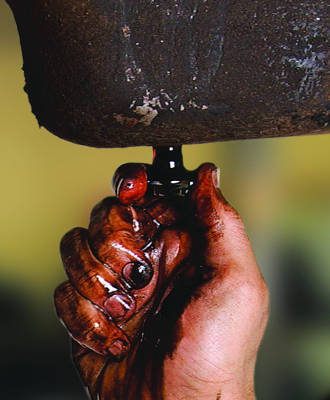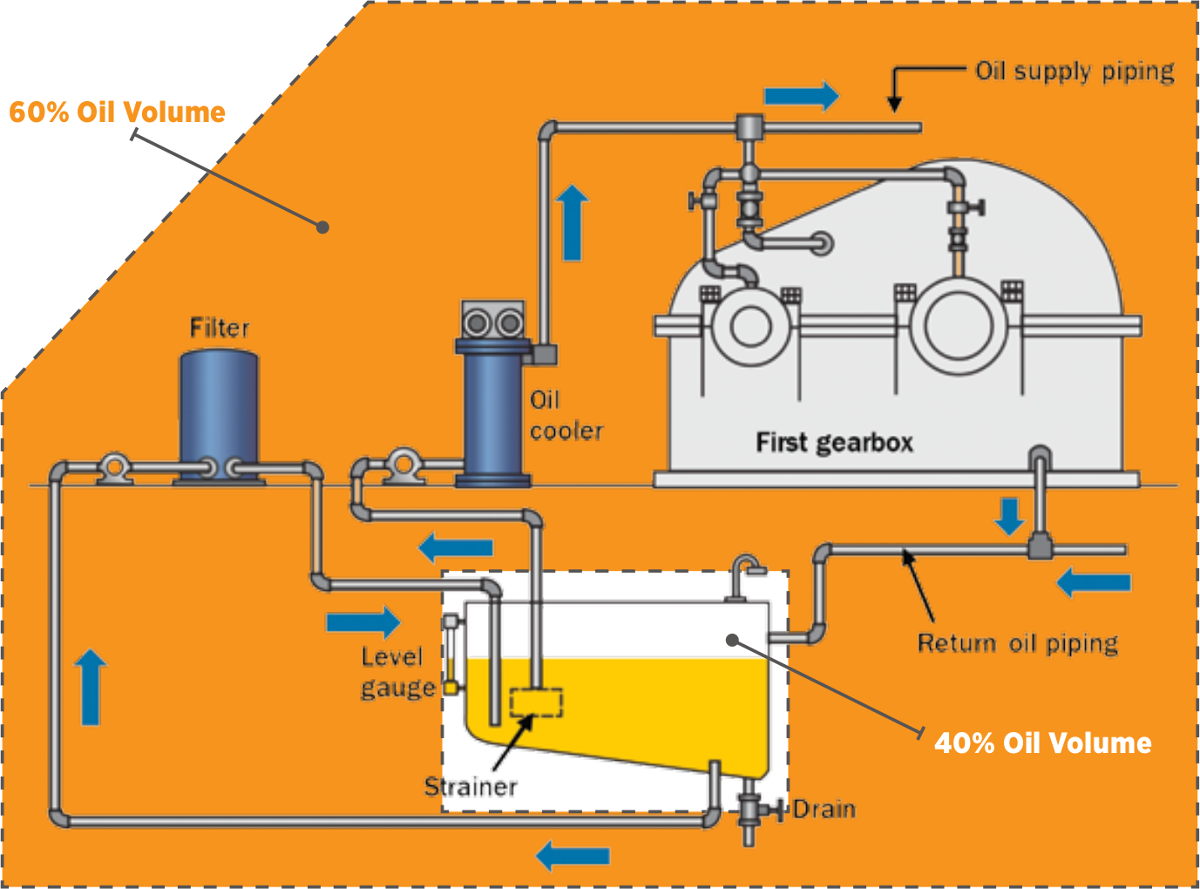Managing the Perils of Short-volume Oil Changes
 The term “short-volume oil change” (SVOC) relates primarily to circulating oil systems. An SVOC occurs when an oil change (either scheduled or condition-based) only involves draining and refilling the oil in the system tank or sump. All or some significant portion of the oil remaining in the oil lines, hoses, bearings, pumps, filters, actuators, valves, heat exchangers, etc., is not changed. In other words, it is a partial oil change.
The term “short-volume oil change” (SVOC) relates primarily to circulating oil systems. An SVOC occurs when an oil change (either scheduled or condition-based) only involves draining and refilling the oil in the system tank or sump. All or some significant portion of the oil remaining in the oil lines, hoses, bearings, pumps, filters, actuators, valves, heat exchangers, etc., is not changed. In other words, it is a partial oil change.
From a practical standpoint, when oil is drained from machines, there is always some residual amount that, at minimum, occludes to interior surfaces and becomes trapped in low regions, quiescent zones, and other nooks and crannies. For example, after an oil drain, diesel engines typically retain approximately 15 percent of their previous oil. When the engine is refilled with new oil, you end up with an 85-to-15 new-oil-to-used-oil blend.
The main concern with this practice is the influence the used oil has on the health of the blended new oil charge. If the used oil was low in volume and relatively healthy, the performance and life expediency of the new oil blend can be acceptable. Conversely, if the used oil was contaminated and/or heavily degraded from extended use, the performance and life expectancy of the new oil blend can be sharply affected. For instance, it takes less than 5 percent oxidized oil mixed with new oil to reduce the oxidation stability of the new oil by more than 90 percent.
Why Perform a Short-volume Oil Change?
There are several good reasons to perform an SVOC. One is that it’s simply less disruption to the system. This includes avoiding the risk of dry start conditions and associated accelerated wear when the machine is restarted due to delayed lubrication (dry start). These conditions are the result of the time required to refill the lines and components with oil, purging out air, etc. Of course, many large systems have auxiliary pumps that pre-lube the system. Other machines may not have this feature.
Furthermore, performing a complete system drain can disturb sludge, sediment and deposits. To read more about this, see my article on oil flushing tips to address the fishbowl effect at MachineryLubrication.com. Unless these solid impurities can be fully purged from the system, they can mobilize within the machine and cause new problems (e.g., motion impediment, restricted oil ways, etc.). Leaks may also occur suddenly in areas where there was no leakage. For more information on this condition, see my article on oil clotting and the adrenaline effect at MachineryLubrication.com.
Unlike an SVOC, where perhaps only 40 percent of the actual oil charge is drained (see Figure 1), a full-volume oil change (FVOC) can take much longer. Additionally, there is much more oil involved and higher associated costs. That said, the service life of an FVOC should be disproportionally longer than an SVOC. For example, the life of an FVOC may be three times longer than a 40-percent SVOC (40 percent new oil blended with 60 percent used oil), and this assumes the used oil is relatively healthy and contaminant free.
One way to define a lubricant’s remaining useful life (RUL) in a machine is to identify the remaining useful life of the additive system. Most additives are sacrificial. In other words, they give up their life to save the oil and the machine. As such, if they don’t die, they aren’t effective. While they are working, they are depleting. Eventually, no reserve additives are left. Of course, you should change the oil long before this point.
For simplicity, let’s assume the antioxidant concentration of new oil is 100. At the time of the SVOC, the used oil had an antioxidant level of 25. The 40-percent SVOC resulted in a blended antioxidant concentration of 55, or 55 percent RUL of the blended oil. This equates to just more than half of the new oil’s designed service life.

Lurking Dangers
Perhaps the most serious hazard relates to current oxidation of the oil being drained. These oxides spread rapidly like food coloring in a pitcher of water. They typically consist of chemically reactive hydroperoxides and free radicals that can burn through antioxidants coming in with the new oil in short order.
You might think of these reactive chemicals as an infection. It’s like sending nine healthy people into a room with a person ailing from a contagious disease. The good health of the nine doesn’t cure the disease of the one. On the contrary, you end up with 10 very sick people. Any time a lubricant is oxidized (e.g., a viscosity increase, dark opaque color, elevated acid number, pungent odor, etc.), a complete system flush is required to purge the infection. Oil analysis can help schedule oil changes well in advance of base oil oxidation. Although less common, a similar problem occurs when a system is infected with microbial contamination (bacteria or fungi).
One of the advantages of an oil change is the opportunity to expunge ghost riders from your oil. Ghost riders are the microscopic hard particles that accumulate in oil over time. They are smaller than the pore size of the onboard oil filter. If you are using a 10-micron oil filter, particles smaller than 10 microns will circulate freely and unabated by filtration. The filter selectively removes only the particles larger than 10 microns. As new particles ingress during normal operation, the small ghost riders continue to grow in population until the oil is changed.
The problem with these ghost riders is that they can do many harmful things to machines. For instance, anywhere there is elastohydrodynamic lubrication (e.g., rolling-element bearings), these small particles can readily bridge the working clearance, damaging bearing surfaces in the load zone. Where boundary lubrication exists (starts, stops, slow-moving surfaces, misalignment, starved oil conditions, etc.), the ghost riders will cause the vast majority of the damage (three-body abrasion and surface fatigue).
The following are additional benefits of an FVOC versus an SVOC:
Machine Devarnishing
New oil usually has a relatively high impurity-holding capacity (IHC) compared to used oil. This means when new oil enters a machine, some of the varnish and deposits from the previous oil can be cleaned away quickly. This devarnishing occurs when the oil has residual IHC aided by a higher operating temperature. Much of this can be lost due to an SVOC. To learn more about IHC, read the article titled “What is Your Oil’s Impurity-holding Capacity (IHC)?” at MachineryLubrication.com.
Better Demulsibility
Most lubricants should demulsify water rapidly to mitigate damage to the oil and the machine. Solid and dissolved impurities of nearly all types build up in used oil and can inhibit demulsibility. These are passed on to the blended new and used oil after an SVOC.
Improved Air-handling Ability
For the same reasons an FVOC is beneficial for demulsibility, it is also good for a lubricant’s efficient air release and low foam tendency/stability.
Longer Filter Life
The impact of soft contaminants (sludge, varnish insolubles, oxides, dead additives, etc.) on filter life can be substantial. Soft contaminants are the product of oil aging. As such, they are purged with FVOCs but less so with SVOCs.
Good Oil Analysis Baseline
Another disadvantage of an SVOC relates to oil analysis. Good oil analysis needs a reliable and consistent new oil baseline. Most oil analysis alarms are set as an offset to this baseline. If the baseline has been corrupted by blending new oil with old oil, so too is the effectiveness (precision) of the oil analysis data interpretation.
| Machine or System |
SVOCPercentage of remaining old oil after the tank is drained and refilled with new oil. This is machine dependent. |
Double Oil ChangeApproximate percentage of old oil remaining after draining and refilling the tank, followed by oil circulation. The drain-and-fill is then repeated. |
SVOC Followed By Line PurgeApproximate percentage of old oil remaining after performing an SVOC, followed by diverting old line oil to waste. |
|---|---|---|---|
| A | 60% | 36% | 12% |
| B | 40% | 16% | 8% |
| C | 30% | 9% | 6% |
| D | 20% | 4% | 4% |
| E | 10% | 1% | 2% |
| F | 5% | 0.25% | 0.5% |
SVOC Alternatives
Fully purging a system of oil can be a difficult challenge. This is especially true with completely flooded lines and system components. The procedure may require partitioning the system, followed by breaking into lines in low zones to drain used oil and aided by air vents in higher zones. There are a couple of alternatives to consider based on the machine, the operating conditions and the need for an FVOC. These include the following (see also the table in Figure 2):
Bleed-and-Feed
This type of oil change normally can be performed on the run for stationary equipment without the loss of machine runtime. The process involves th e progressive draining of tank oil and the addition of an equal amount of new oil, all while the oil remains circulating. For heavily degraded lube oil, it may take the equivalent of three or four oil changes (in new oil volume) to achieve the target level of oil quality and performance.
Double Oil Change
This will require a machine stoppage. The tank is drained and refilled in the same manner as with a normal SVOC. The oil is then brought back to operating temperature while circulating. Afterward, the oil tank is drained and refilled again.
SVOC Followed by a Line Purge
After the tank has been drained and refilled with new oil, the auxiliary pump is started and the new oil is pushed into the system. The old oil is not returned to the tank but rather diverted to waste until most of the old line oil has been discharged. The tank is then refilled to the correct level, and the return line is reconnected to the tank. Alternate procedures can achieve similar results depending on the machine/system involved.
Role of Oil Analysis
Oil analysis and Inspection 2.0 can substantially improve the outcome of SVOCs and mitigate the risks. This is largely the practice of carefully monitoring the aging health of the used oil and recognizing the sudden and escalating presence of a problem. Issues might include premature oil oxidation, the need for dehydration or portable filtration, rising varnish potential, the need for additive reconstruction and abnormal ghost rider concentration.
For large and critical systems, the timing of the oil change is key. The best way to ensure good timing is to allow the oil to talk to you through effective oil analysis and inspection. When done correctly, these methods will enable you to achieve optimum results.
